Management Law Assignment: Contract, Negligence, and Consumer Law
VerifiedAdded on 2020/03/16
|10
|1901
|196
Homework Assignment
AI Summary
This management law assignment addresses several key legal issues. The first question examines the validity of an agreement signed under duress, analyzing the principles of contract law and the concept of free consent. The second question explores promissory estoppel in a car sale scenario, determining if a promise to buy a car is legally binding. The third question delves into negligence, assessing a chef's liability for serving poisonous fish, considering defenses like voluntary assumption of risk. Finally, the fourth question analyzes consumer law, particularly misleading advertising, and determines the rights of a consumer who received a product different from the advertisement. The assignment references relevant case law and legislation, including the Australian Consumer Act and Civil Liability Act.
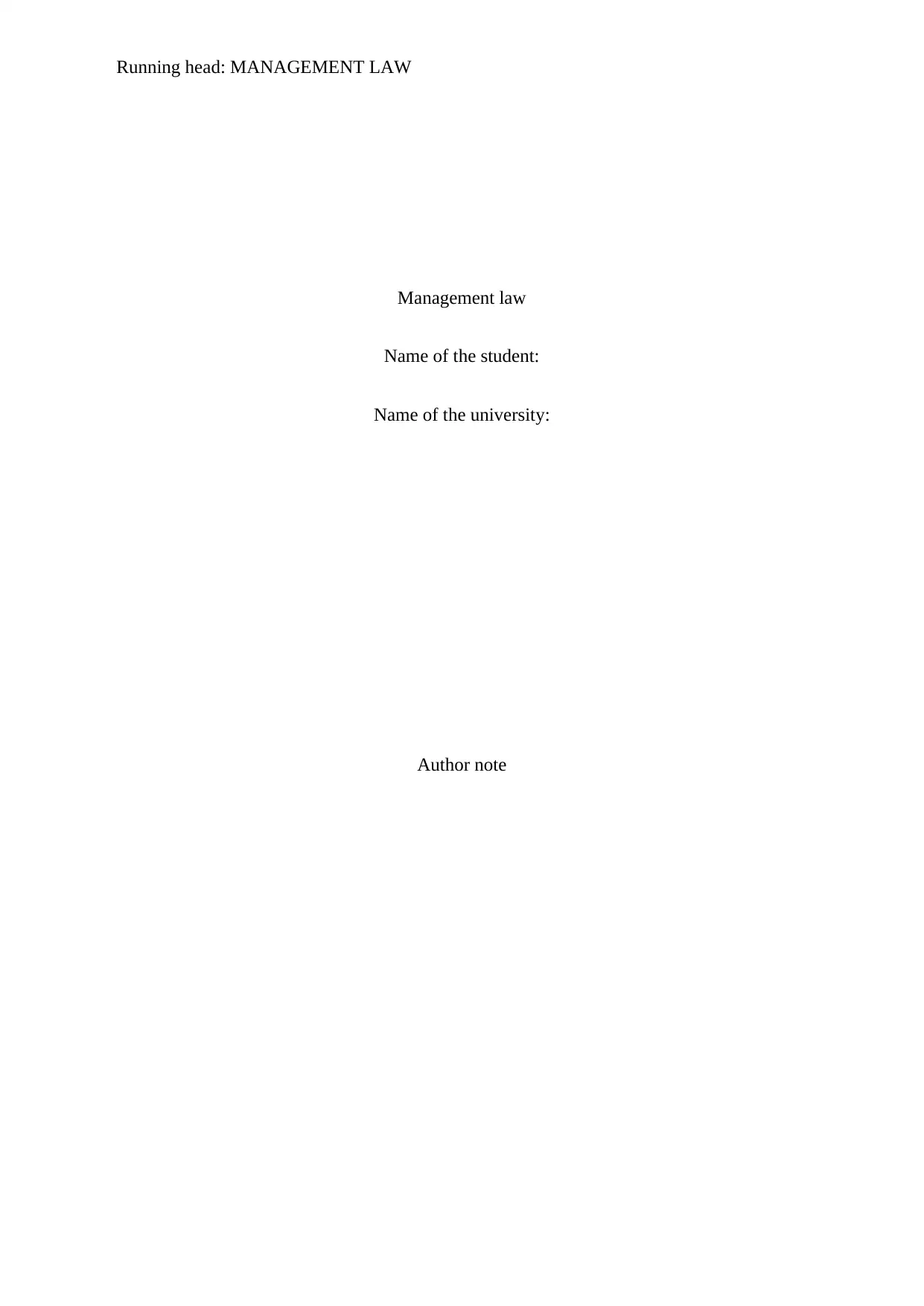
Running head: MANAGEMENT LAW
Management law
Name of the student:
Name of the university:
Author note
Management law
Name of the student:
Name of the university:
Author note
Paraphrase This Document
Need a fresh take? Get an instant paraphrase of this document with our AI Paraphraser
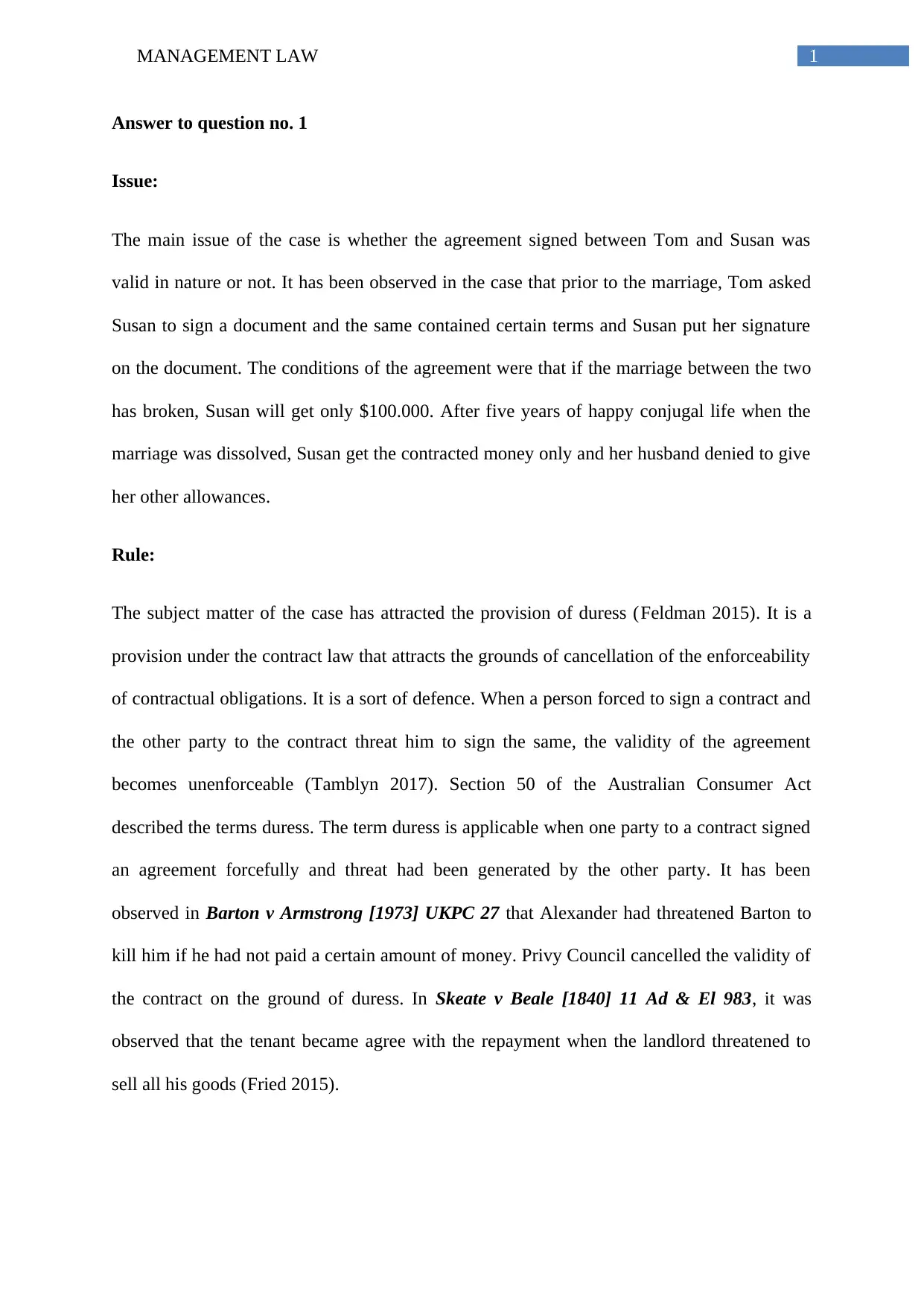
1MANAGEMENT LAW
Answer to question no. 1
Issue:
The main issue of the case is whether the agreement signed between Tom and Susan was
valid in nature or not. It has been observed in the case that prior to the marriage, Tom asked
Susan to sign a document and the same contained certain terms and Susan put her signature
on the document. The conditions of the agreement were that if the marriage between the two
has broken, Susan will get only $100.000. After five years of happy conjugal life when the
marriage was dissolved, Susan get the contracted money only and her husband denied to give
her other allowances.
Rule:
The subject matter of the case has attracted the provision of duress (Feldman 2015). It is a
provision under the contract law that attracts the grounds of cancellation of the enforceability
of contractual obligations. It is a sort of defence. When a person forced to sign a contract and
the other party to the contract threat him to sign the same, the validity of the agreement
becomes unenforceable (Tamblyn 2017). Section 50 of the Australian Consumer Act
described the terms duress. The term duress is applicable when one party to a contract signed
an agreement forcefully and threat had been generated by the other party. It has been
observed in Barton v Armstrong [1973] UKPC 27 that Alexander had threatened Barton to
kill him if he had not paid a certain amount of money. Privy Council cancelled the validity of
the contract on the ground of duress. In Skeate v Beale [1840] 11 Ad & El 983, it was
observed that the tenant became agree with the repayment when the landlord threatened to
sell all his goods (Fried 2015).
Answer to question no. 1
Issue:
The main issue of the case is whether the agreement signed between Tom and Susan was
valid in nature or not. It has been observed in the case that prior to the marriage, Tom asked
Susan to sign a document and the same contained certain terms and Susan put her signature
on the document. The conditions of the agreement were that if the marriage between the two
has broken, Susan will get only $100.000. After five years of happy conjugal life when the
marriage was dissolved, Susan get the contracted money only and her husband denied to give
her other allowances.
Rule:
The subject matter of the case has attracted the provision of duress (Feldman 2015). It is a
provision under the contract law that attracts the grounds of cancellation of the enforceability
of contractual obligations. It is a sort of defence. When a person forced to sign a contract and
the other party to the contract threat him to sign the same, the validity of the agreement
becomes unenforceable (Tamblyn 2017). Section 50 of the Australian Consumer Act
described the terms duress. The term duress is applicable when one party to a contract signed
an agreement forcefully and threat had been generated by the other party. It has been
observed in Barton v Armstrong [1973] UKPC 27 that Alexander had threatened Barton to
kill him if he had not paid a certain amount of money. Privy Council cancelled the validity of
the contract on the ground of duress. In Skeate v Beale [1840] 11 Ad & El 983, it was
observed that the tenant became agree with the repayment when the landlord threatened to
sell all his goods (Fried 2015).
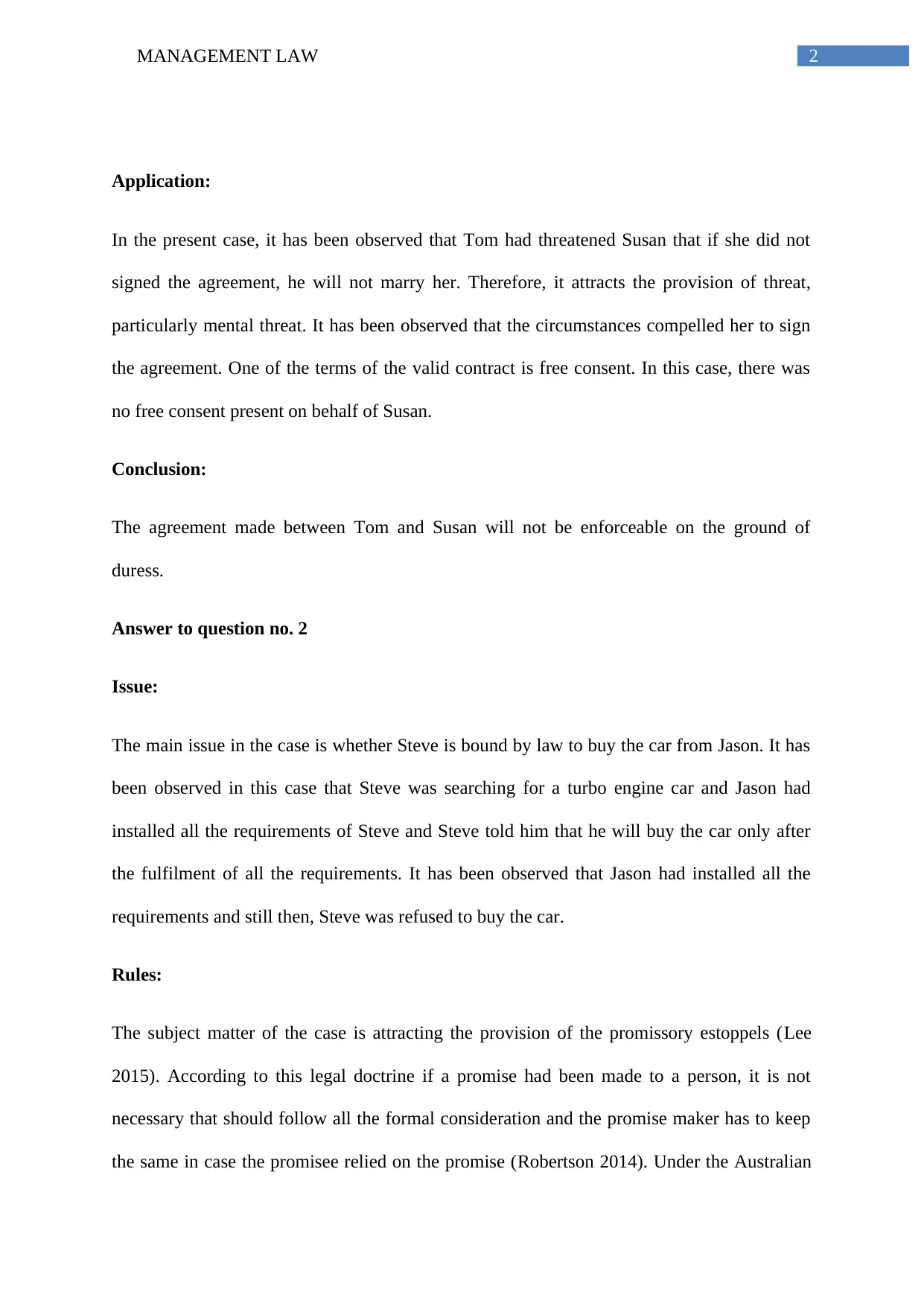
2MANAGEMENT LAW
Application:
In the present case, it has been observed that Tom had threatened Susan that if she did not
signed the agreement, he will not marry her. Therefore, it attracts the provision of threat,
particularly mental threat. It has been observed that the circumstances compelled her to sign
the agreement. One of the terms of the valid contract is free consent. In this case, there was
no free consent present on behalf of Susan.
Conclusion:
The agreement made between Tom and Susan will not be enforceable on the ground of
duress.
Answer to question no. 2
Issue:
The main issue in the case is whether Steve is bound by law to buy the car from Jason. It has
been observed in this case that Steve was searching for a turbo engine car and Jason had
installed all the requirements of Steve and Steve told him that he will buy the car only after
the fulfilment of all the requirements. It has been observed that Jason had installed all the
requirements and still then, Steve was refused to buy the car.
Rules:
The subject matter of the case is attracting the provision of the promissory estoppels (Lee
2015). According to this legal doctrine if a promise had been made to a person, it is not
necessary that should follow all the formal consideration and the promise maker has to keep
the same in case the promisee relied on the promise (Robertson 2014). Under the Australian
Application:
In the present case, it has been observed that Tom had threatened Susan that if she did not
signed the agreement, he will not marry her. Therefore, it attracts the provision of threat,
particularly mental threat. It has been observed that the circumstances compelled her to sign
the agreement. One of the terms of the valid contract is free consent. In this case, there was
no free consent present on behalf of Susan.
Conclusion:
The agreement made between Tom and Susan will not be enforceable on the ground of
duress.
Answer to question no. 2
Issue:
The main issue in the case is whether Steve is bound by law to buy the car from Jason. It has
been observed in this case that Steve was searching for a turbo engine car and Jason had
installed all the requirements of Steve and Steve told him that he will buy the car only after
the fulfilment of all the requirements. It has been observed that Jason had installed all the
requirements and still then, Steve was refused to buy the car.
Rules:
The subject matter of the case is attracting the provision of the promissory estoppels (Lee
2015). According to this legal doctrine if a promise had been made to a person, it is not
necessary that should follow all the formal consideration and the promise maker has to keep
the same in case the promisee relied on the promise (Robertson 2014). Under the Australian
⊘ This is a preview!⊘
Do you want full access?
Subscribe today to unlock all pages.

Trusted by 1+ million students worldwide
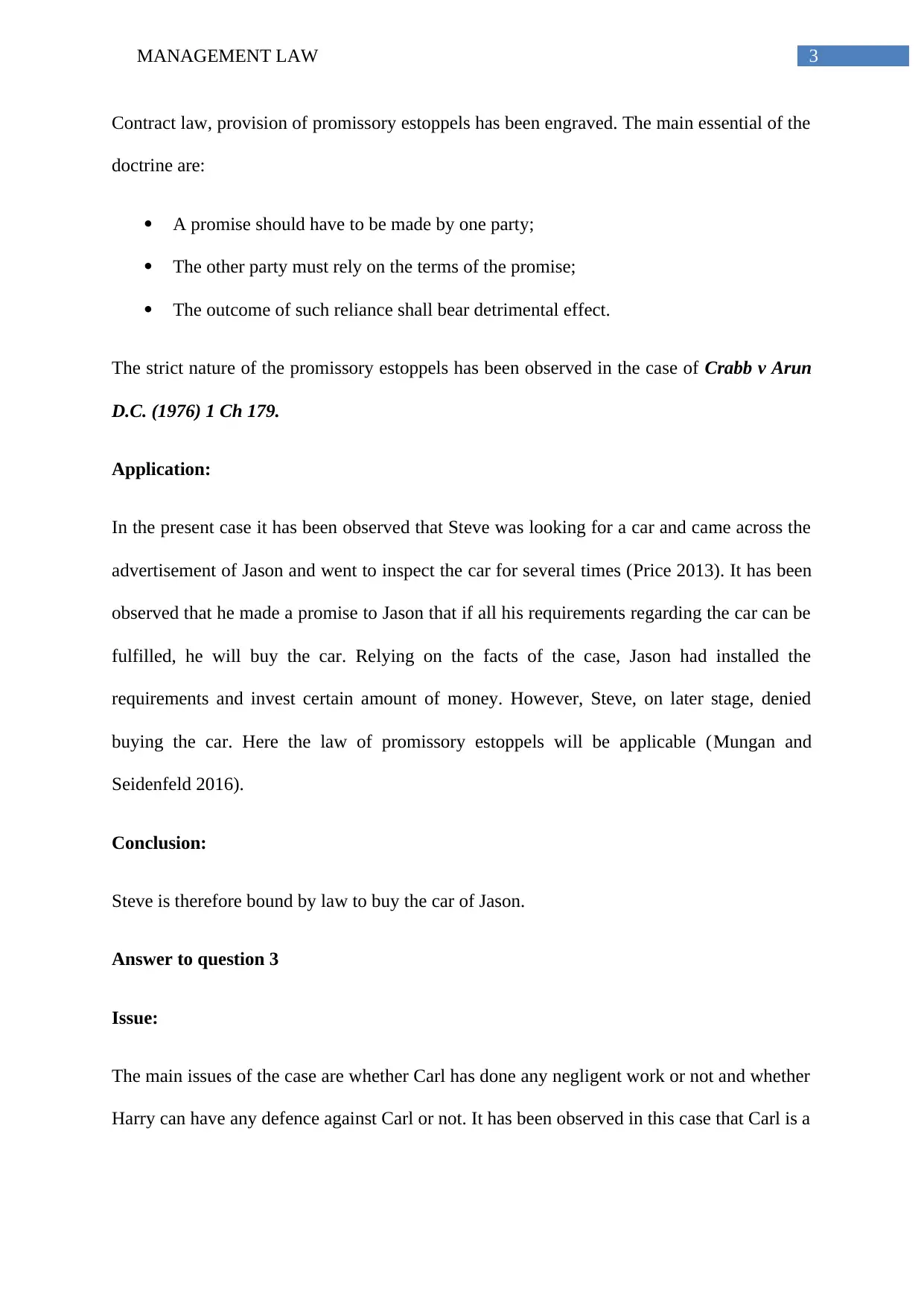
3MANAGEMENT LAW
Contract law, provision of promissory estoppels has been engraved. The main essential of the
doctrine are:
A promise should have to be made by one party;
The other party must rely on the terms of the promise;
The outcome of such reliance shall bear detrimental effect.
The strict nature of the promissory estoppels has been observed in the case of Crabb v Arun
D.C. (1976) 1 Ch 179.
Application:
In the present case it has been observed that Steve was looking for a car and came across the
advertisement of Jason and went to inspect the car for several times (Price 2013). It has been
observed that he made a promise to Jason that if all his requirements regarding the car can be
fulfilled, he will buy the car. Relying on the facts of the case, Jason had installed the
requirements and invest certain amount of money. However, Steve, on later stage, denied
buying the car. Here the law of promissory estoppels will be applicable (Mungan and
Seidenfeld 2016).
Conclusion:
Steve is therefore bound by law to buy the car of Jason.
Answer to question 3
Issue:
The main issues of the case are whether Carl has done any negligent work or not and whether
Harry can have any defence against Carl or not. It has been observed in this case that Carl is a
Contract law, provision of promissory estoppels has been engraved. The main essential of the
doctrine are:
A promise should have to be made by one party;
The other party must rely on the terms of the promise;
The outcome of such reliance shall bear detrimental effect.
The strict nature of the promissory estoppels has been observed in the case of Crabb v Arun
D.C. (1976) 1 Ch 179.
Application:
In the present case it has been observed that Steve was looking for a car and came across the
advertisement of Jason and went to inspect the car for several times (Price 2013). It has been
observed that he made a promise to Jason that if all his requirements regarding the car can be
fulfilled, he will buy the car. Relying on the facts of the case, Jason had installed the
requirements and invest certain amount of money. However, Steve, on later stage, denied
buying the car. Here the law of promissory estoppels will be applicable (Mungan and
Seidenfeld 2016).
Conclusion:
Steve is therefore bound by law to buy the car of Jason.
Answer to question 3
Issue:
The main issues of the case are whether Carl has done any negligent work or not and whether
Harry can have any defence against Carl or not. It has been observed in this case that Carl is a
Paraphrase This Document
Need a fresh take? Get an instant paraphrase of this document with our AI Paraphraser
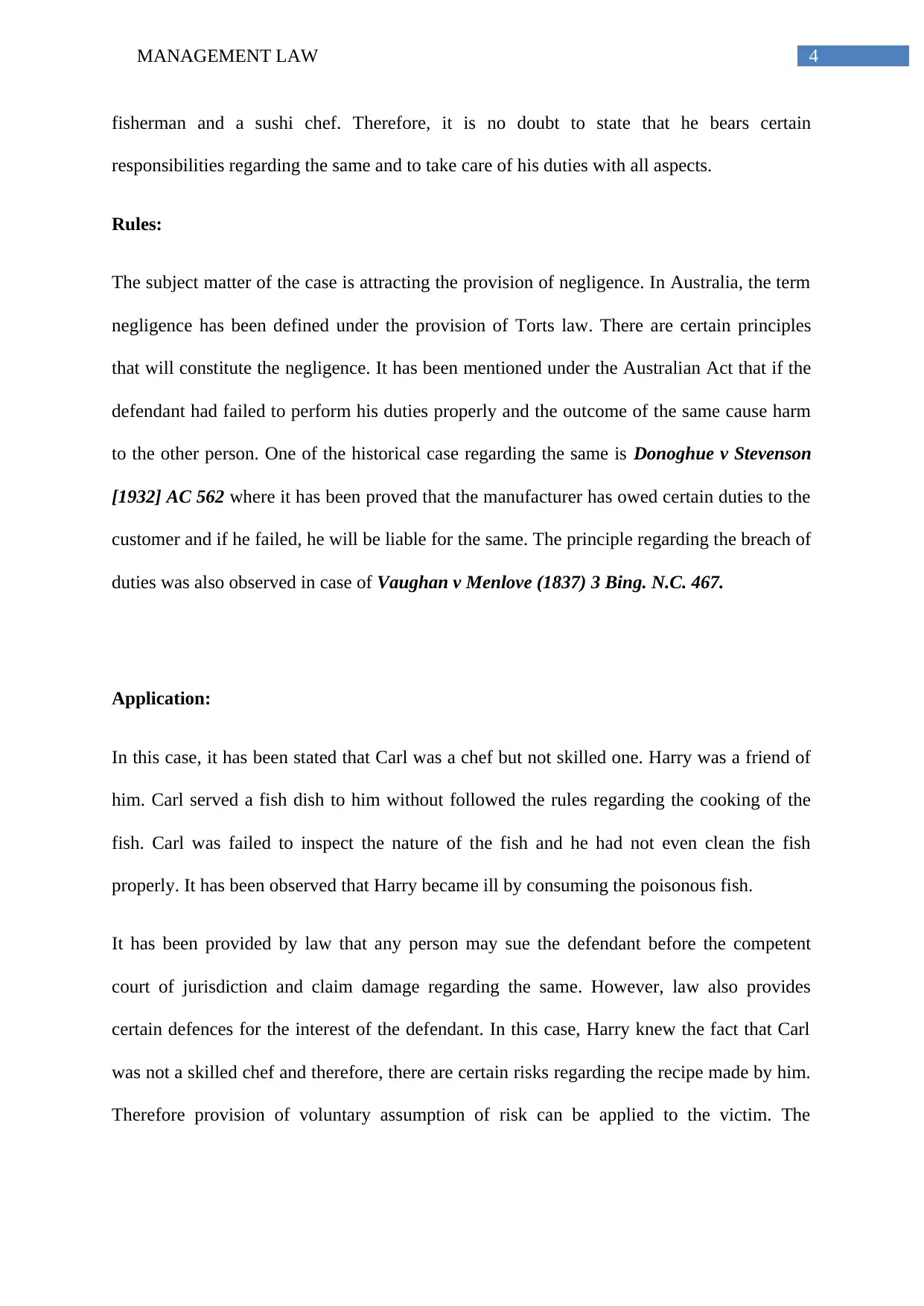
4MANAGEMENT LAW
fisherman and a sushi chef. Therefore, it is no doubt to state that he bears certain
responsibilities regarding the same and to take care of his duties with all aspects.
Rules:
The subject matter of the case is attracting the provision of negligence. In Australia, the term
negligence has been defined under the provision of Torts law. There are certain principles
that will constitute the negligence. It has been mentioned under the Australian Act that if the
defendant had failed to perform his duties properly and the outcome of the same cause harm
to the other person. One of the historical case regarding the same is Donoghue v Stevenson
[1932] AC 562 where it has been proved that the manufacturer has owed certain duties to the
customer and if he failed, he will be liable for the same. The principle regarding the breach of
duties was also observed in case of Vaughan v Menlove (1837) 3 Bing. N.C. 467.
Application:
In this case, it has been stated that Carl was a chef but not skilled one. Harry was a friend of
him. Carl served a fish dish to him without followed the rules regarding the cooking of the
fish. Carl was failed to inspect the nature of the fish and he had not even clean the fish
properly. It has been observed that Harry became ill by consuming the poisonous fish.
It has been provided by law that any person may sue the defendant before the competent
court of jurisdiction and claim damage regarding the same. However, law also provides
certain defences for the interest of the defendant. In this case, Harry knew the fact that Carl
was not a skilled chef and therefore, there are certain risks regarding the recipe made by him.
Therefore provision of voluntary assumption of risk can be applied to the victim. The
fisherman and a sushi chef. Therefore, it is no doubt to state that he bears certain
responsibilities regarding the same and to take care of his duties with all aspects.
Rules:
The subject matter of the case is attracting the provision of negligence. In Australia, the term
negligence has been defined under the provision of Torts law. There are certain principles
that will constitute the negligence. It has been mentioned under the Australian Act that if the
defendant had failed to perform his duties properly and the outcome of the same cause harm
to the other person. One of the historical case regarding the same is Donoghue v Stevenson
[1932] AC 562 where it has been proved that the manufacturer has owed certain duties to the
customer and if he failed, he will be liable for the same. The principle regarding the breach of
duties was also observed in case of Vaughan v Menlove (1837) 3 Bing. N.C. 467.
Application:
In this case, it has been stated that Carl was a chef but not skilled one. Harry was a friend of
him. Carl served a fish dish to him without followed the rules regarding the cooking of the
fish. Carl was failed to inspect the nature of the fish and he had not even clean the fish
properly. It has been observed that Harry became ill by consuming the poisonous fish.
It has been provided by law that any person may sue the defendant before the competent
court of jurisdiction and claim damage regarding the same. However, law also provides
certain defences for the interest of the defendant. In this case, Harry knew the fact that Carl
was not a skilled chef and therefore, there are certain risks regarding the recipe made by him.
Therefore provision of voluntary assumption of risk can be applied to the victim. The
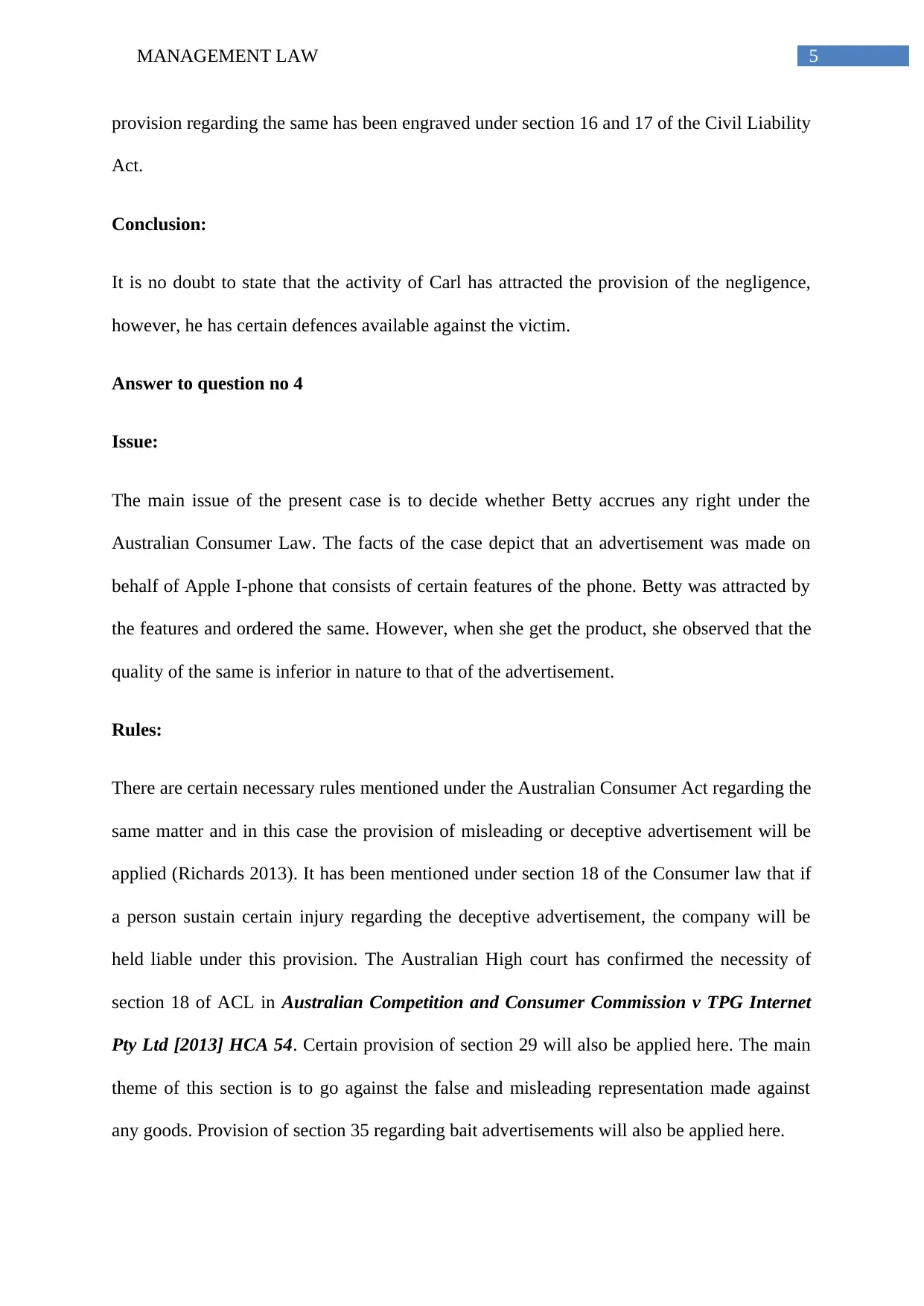
5MANAGEMENT LAW
provision regarding the same has been engraved under section 16 and 17 of the Civil Liability
Act.
Conclusion:
It is no doubt to state that the activity of Carl has attracted the provision of the negligence,
however, he has certain defences available against the victim.
Answer to question no 4
Issue:
The main issue of the present case is to decide whether Betty accrues any right under the
Australian Consumer Law. The facts of the case depict that an advertisement was made on
behalf of Apple I-phone that consists of certain features of the phone. Betty was attracted by
the features and ordered the same. However, when she get the product, she observed that the
quality of the same is inferior in nature to that of the advertisement.
Rules:
There are certain necessary rules mentioned under the Australian Consumer Act regarding the
same matter and in this case the provision of misleading or deceptive advertisement will be
applied (Richards 2013). It has been mentioned under section 18 of the Consumer law that if
a person sustain certain injury regarding the deceptive advertisement, the company will be
held liable under this provision. The Australian High court has confirmed the necessity of
section 18 of ACL in Australian Competition and Consumer Commission v TPG Internet
Pty Ltd [2013] HCA 54. Certain provision of section 29 will also be applied here. The main
theme of this section is to go against the false and misleading representation made against
any goods. Provision of section 35 regarding bait advertisements will also be applied here.
provision regarding the same has been engraved under section 16 and 17 of the Civil Liability
Act.
Conclusion:
It is no doubt to state that the activity of Carl has attracted the provision of the negligence,
however, he has certain defences available against the victim.
Answer to question no 4
Issue:
The main issue of the present case is to decide whether Betty accrues any right under the
Australian Consumer Law. The facts of the case depict that an advertisement was made on
behalf of Apple I-phone that consists of certain features of the phone. Betty was attracted by
the features and ordered the same. However, when she get the product, she observed that the
quality of the same is inferior in nature to that of the advertisement.
Rules:
There are certain necessary rules mentioned under the Australian Consumer Act regarding the
same matter and in this case the provision of misleading or deceptive advertisement will be
applied (Richards 2013). It has been mentioned under section 18 of the Consumer law that if
a person sustain certain injury regarding the deceptive advertisement, the company will be
held liable under this provision. The Australian High court has confirmed the necessity of
section 18 of ACL in Australian Competition and Consumer Commission v TPG Internet
Pty Ltd [2013] HCA 54. Certain provision of section 29 will also be applied here. The main
theme of this section is to go against the false and misleading representation made against
any goods. Provision of section 35 regarding bait advertisements will also be applied here.
⊘ This is a preview!⊘
Do you want full access?
Subscribe today to unlock all pages.

Trusted by 1+ million students worldwide
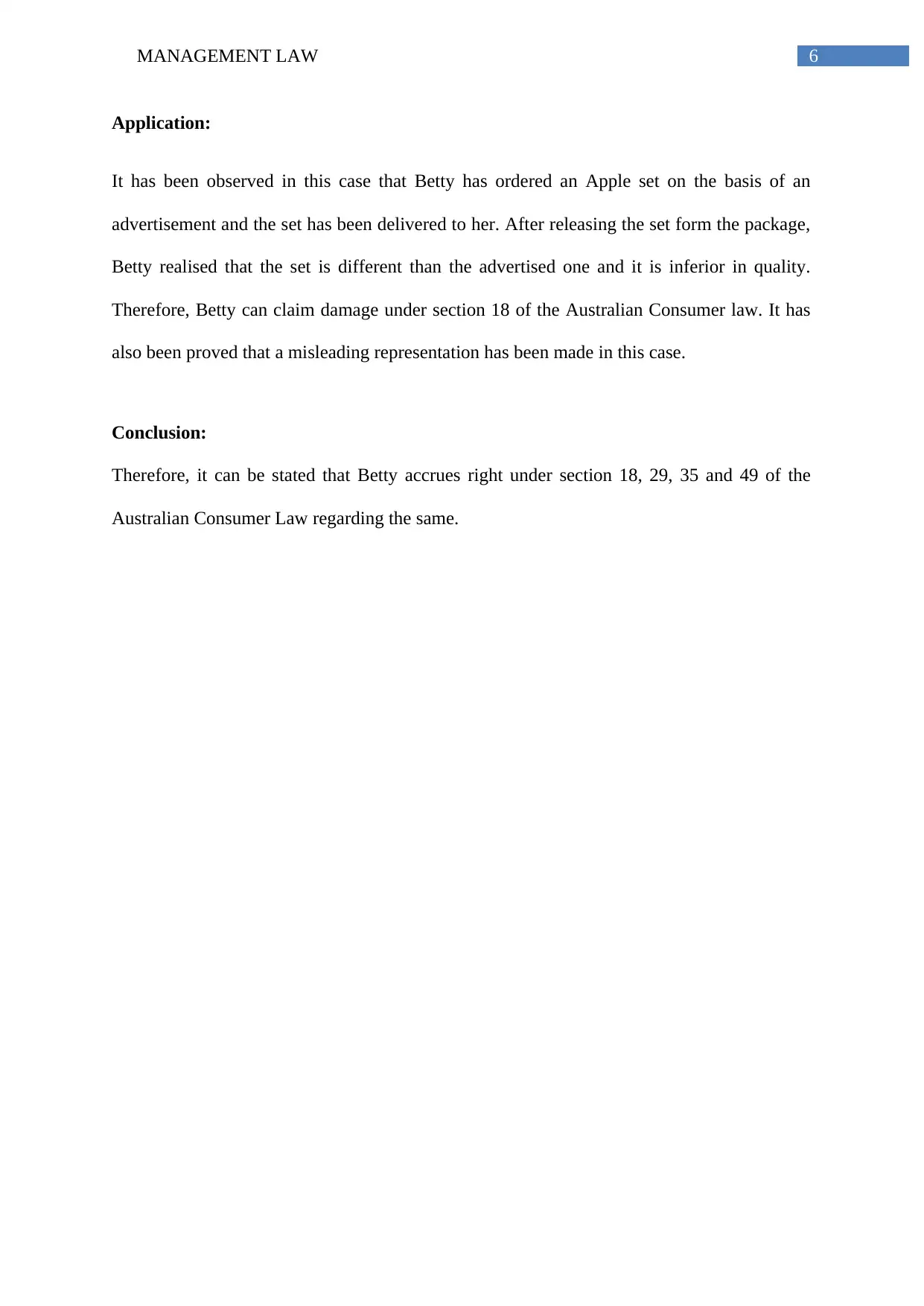
6MANAGEMENT LAW
Application:
It has been observed in this case that Betty has ordered an Apple set on the basis of an
advertisement and the set has been delivered to her. After releasing the set form the package,
Betty realised that the set is different than the advertised one and it is inferior in quality.
Therefore, Betty can claim damage under section 18 of the Australian Consumer law. It has
also been proved that a misleading representation has been made in this case.
Conclusion:
Therefore, it can be stated that Betty accrues right under section 18, 29, 35 and 49 of the
Australian Consumer Law regarding the same.
Application:
It has been observed in this case that Betty has ordered an Apple set on the basis of an
advertisement and the set has been delivered to her. After releasing the set form the package,
Betty realised that the set is different than the advertised one and it is inferior in quality.
Therefore, Betty can claim damage under section 18 of the Australian Consumer law. It has
also been proved that a misleading representation has been made in this case.
Conclusion:
Therefore, it can be stated that Betty accrues right under section 18, 29, 35 and 49 of the
Australian Consumer Law regarding the same.
Paraphrase This Document
Need a fresh take? Get an instant paraphrase of this document with our AI Paraphraser
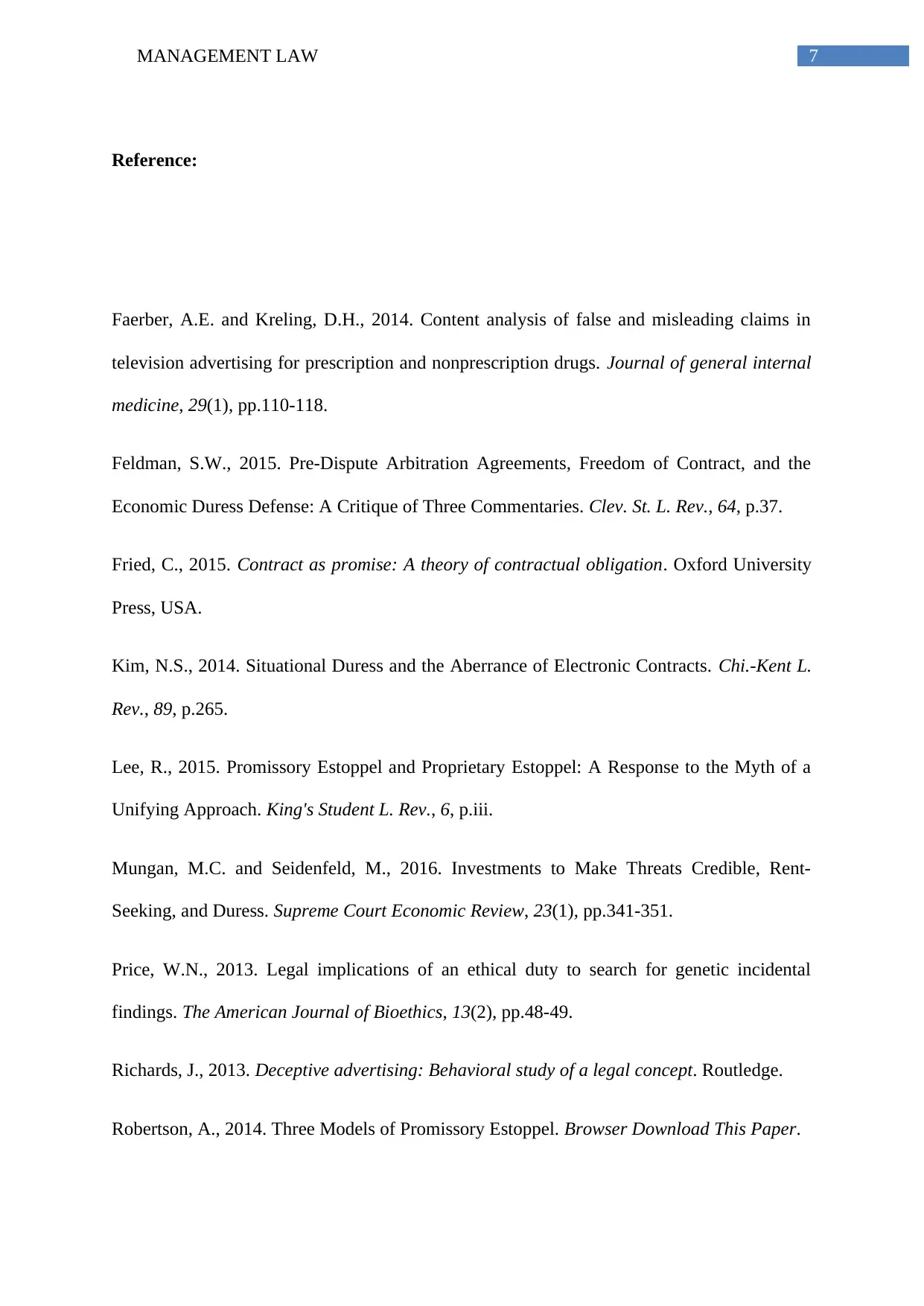
7MANAGEMENT LAW
Reference:
Faerber, A.E. and Kreling, D.H., 2014. Content analysis of false and misleading claims in
television advertising for prescription and nonprescription drugs. Journal of general internal
medicine, 29(1), pp.110-118.
Feldman, S.W., 2015. Pre-Dispute Arbitration Agreements, Freedom of Contract, and the
Economic Duress Defense: A Critique of Three Commentaries. Clev. St. L. Rev., 64, p.37.
Fried, C., 2015. Contract as promise: A theory of contractual obligation. Oxford University
Press, USA.
Kim, N.S., 2014. Situational Duress and the Aberrance of Electronic Contracts. Chi.-Kent L.
Rev., 89, p.265.
Lee, R., 2015. Promissory Estoppel and Proprietary Estoppel: A Response to the Myth of a
Unifying Approach. King's Student L. Rev., 6, p.iii.
Mungan, M.C. and Seidenfeld, M., 2016. Investments to Make Threats Credible, Rent-
Seeking, and Duress. Supreme Court Economic Review, 23(1), pp.341-351.
Price, W.N., 2013. Legal implications of an ethical duty to search for genetic incidental
findings. The American Journal of Bioethics, 13(2), pp.48-49.
Richards, J., 2013. Deceptive advertising: Behavioral study of a legal concept. Routledge.
Robertson, A., 2014. Three Models of Promissory Estoppel. Browser Download This Paper.
Reference:
Faerber, A.E. and Kreling, D.H., 2014. Content analysis of false and misleading claims in
television advertising for prescription and nonprescription drugs. Journal of general internal
medicine, 29(1), pp.110-118.
Feldman, S.W., 2015. Pre-Dispute Arbitration Agreements, Freedom of Contract, and the
Economic Duress Defense: A Critique of Three Commentaries. Clev. St. L. Rev., 64, p.37.
Fried, C., 2015. Contract as promise: A theory of contractual obligation. Oxford University
Press, USA.
Kim, N.S., 2014. Situational Duress and the Aberrance of Electronic Contracts. Chi.-Kent L.
Rev., 89, p.265.
Lee, R., 2015. Promissory Estoppel and Proprietary Estoppel: A Response to the Myth of a
Unifying Approach. King's Student L. Rev., 6, p.iii.
Mungan, M.C. and Seidenfeld, M., 2016. Investments to Make Threats Credible, Rent-
Seeking, and Duress. Supreme Court Economic Review, 23(1), pp.341-351.
Price, W.N., 2013. Legal implications of an ethical duty to search for genetic incidental
findings. The American Journal of Bioethics, 13(2), pp.48-49.
Richards, J., 2013. Deceptive advertising: Behavioral study of a legal concept. Routledge.
Robertson, A., 2014. Three Models of Promissory Estoppel. Browser Download This Paper.
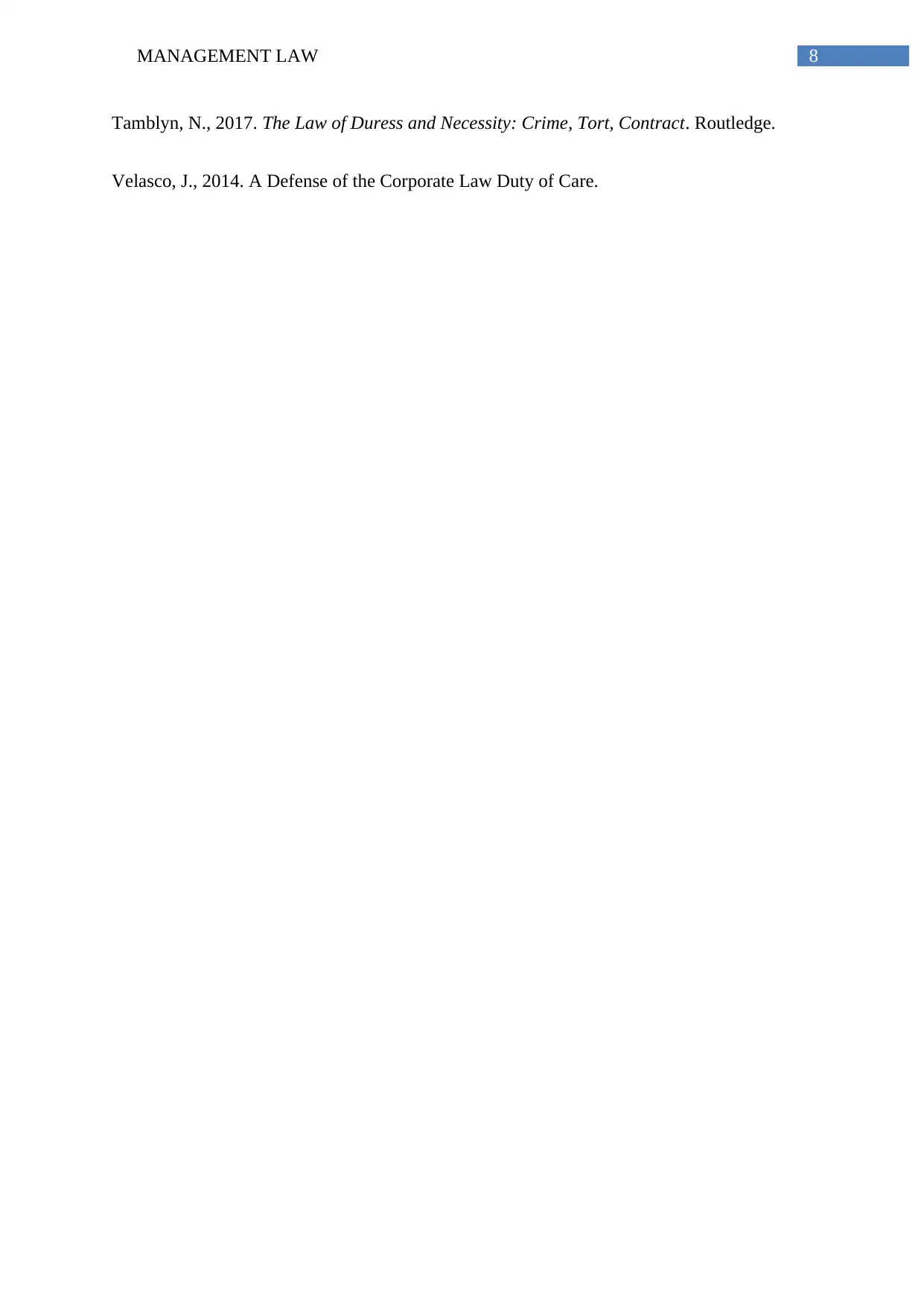
8MANAGEMENT LAW
Tamblyn, N., 2017. The Law of Duress and Necessity: Crime, Tort, Contract. Routledge.
Velasco, J., 2014. A Defense of the Corporate Law Duty of Care.
Tamblyn, N., 2017. The Law of Duress and Necessity: Crime, Tort, Contract. Routledge.
Velasco, J., 2014. A Defense of the Corporate Law Duty of Care.
⊘ This is a preview!⊘
Do you want full access?
Subscribe today to unlock all pages.

Trusted by 1+ million students worldwide
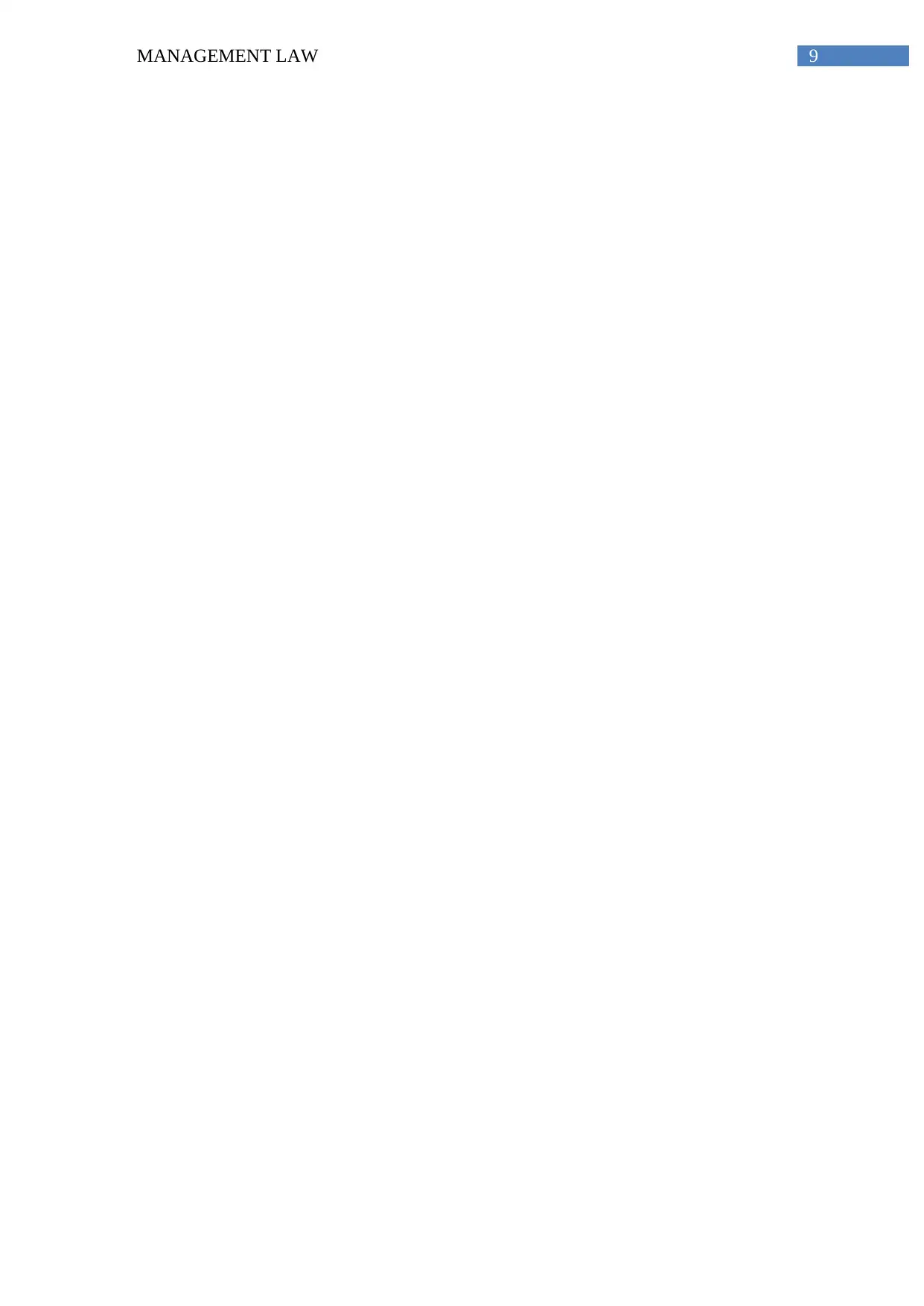
9MANAGEMENT LAW
1 out of 10
Related Documents
Your All-in-One AI-Powered Toolkit for Academic Success.
+13062052269
info@desklib.com
Available 24*7 on WhatsApp / Email
![[object Object]](/_next/static/media/star-bottom.7253800d.svg)
Unlock your academic potential
Copyright © 2020–2025 A2Z Services. All Rights Reserved. Developed and managed by ZUCOL.


![Management Law 2 Assignment - [University Name] - Semester 2](/_next/image/?url=https%3A%2F%2Fdesklib.com%2Fmedia%2Fimages%2Foc%2F38e706355e0d4bf19ce1377653715513.jpg&w=256&q=75)


